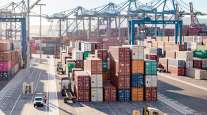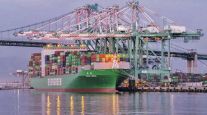Los Angeles Daily News
Los Angeles, Long Beach Ports Hail Supply Chain Progress
[Stay on top of transportation news: Get TTNews in your inbox.]
In January, a record 109 ships awaited entry into the combined ports of Los Angeles and Long Beach, often stretching to south Orange County.
It marked a peak in the supply chain congestion that has bedeviled the nation’s two busiest ports during much of the pandemic.
On Aug. 11, that number stood at nine ships.
“Just amazing,” Port of L.A. Executive Director Gene Seroka said about the decline.
“We’ve reduced the number of anchored ships by 90-some percent,” Seroka said in a recent phone interview, “while still moving record amounts of cargo in the first six months of this year.”
Among the most impactful tools the ports are now utilizing are sophisticated digital data trackers that give the seaports invaluable information on what ships are headed their way, how much cargo they’re bringing in and when they will arrive.
“We’re a lot smarter than we were a year ago,” Seroka said, adding that collaboration has seen a big boost throughout the supply chain as solutions are explored.
“I feel really good about where we are compared to last October,” Seroka said, adding that while he knew the digital tracking would make big improvements, he didn’t know how much or “how detailed it could get.”
But the supply chain is far from fixed.
#POLB had its busiest July despite a cooldown in consumer spending. Dockworkers and terminal operators moved 785,843 TEUs in July, a slim 0.13% increase from the previous record set in July 2021. Imports declined 1.8%, while exports were down 0.5%. https://t.co/GLJY9HwWsG pic.twitter.com/aegZKAwAXl — Port of Long Beach (@portoflongbeach) August 9, 2022
While a nationwide push to shore up the supply chain’s vulnerabilities — a push that has included the White House, the ports and labor unions, to name a few — has made strides, a new wrinkle looms.
And wrinkles can spread fast.
A buildup of cargo being handled by the nation’s major rail carriers has pushed up the ports’ terminal dwell times. The rail carriers, officials have said, are dealing with a lack of equipment and workers, which the train companies have also acknowledged.
But how critical the rail problems are for the supply chain in general and efforts by the L.A. and Long Beach ports to reduce their cargo backlog doesn’t appear to be settled.
“It does affect” the supply chain, Seroka said of the rail situation, “but it’s not putting us in dire straits and we’re not in gridlock.”
Others, however, see potential trouble on the way.
“The current state of freight rail is not great,” said Marty Oberman, chairman of the Surface Transportation Board, which regulates disputes involving railroad rates, mergers and other matters.
Oberman was among several speakers at a virtual U.S. Freight and Railroad Worker Town Hall meeting on Aug. 12.
Rail workers, who are embroiled in a union contract negotiation that has gone on for three years, said during the town hall their employers laid much of the groundwork for the problems themselves by laying off some 45,000 people during the coronavirus pandemic.
A good number of those workers never returned and the challenge of training new hires quickly has proven difficult. A lack of equipment, such as locomotives and chassis, has also caused problems, those who spoke at the town hall said.
Officials for the two biggest rail carriers operating out of the L.A. and Long Beach ports said their companies are working to hire more employees and add equipment. But one of those officials, in a statement, also appeared to shift responsibility for supply chain issues overall onto other aspects of that nuanced and complex logistics network.
Another problem raised during the town hall discussion, meanwhile, was the trend toward longer trains posing challenges for maintenance and schedules.
“The railroads cannot even provide us with a schedule of arriving trains into the port,” said town hall participant Ramon Ponce De Leon, coast committeeman for the longshore union. “There are longer wait times being passed on to consumers and we’ve had a record number of cargo sitting on the docks. This is totally unacceptable.”
Many of the workers blamed the precision scheduled railroading system, or PSR, which is used by Union Pacific Railroad but not by Burlington Northern and Santa Fe Railway, more commonly known as BNSF.
The idea is aimed at simplifying routing networks, but the system has drawn criticism from rail workers and shippers.
“PSR isn’t working,” said Vince Verna, vice president and national representative for the Brotherhood of Locomotives and Trainmen in the Teamsters. “We’ve really seen and heard things going downhill with the adoption of the new business model, the discontent started in 2015. Precision scheduled railroading is neither precise nor scheduled; it’s created a very chaotic and ineffective way of doing business.”
Critics say the platform, introduced before the pandemic, took rail companies away from customer service priorities to a focus on profits.
“This is going to require long-term solutions,” said Greg Regan, president of Transportation Trades in the AFL-CIO, who moderated the virtual town hall. “There’s not going to be quick fixes.”
Robynn Tysver, a spokeswoman for Union Pacific Railroad, said that company is working hard to add employees and equipment as it tackles the supply chain challenges.
“Railroads are just one piece of the supply chain,” she said in an email, “the middle miles between ocean carriers and shippers and truck drivers and warehouses — that control the critical ‘first and last miles.’
“(Union Pacific) takes its responsibility as a major part of the global supply chain seriously, and we’ve taken many steps to improve fluidity, such as adding employees and locomotives,” Tysver added. “The 1,400 train crew employees we are on track to hire this year will help us continue to meet current demand, as well as what we are projecting over the next 12-24 months.”
Mario Cordero, executive director of the Port of Long Beach, concurred with Seroka that “terminals and dockworkers have made tremendous progress in bringing down the San Pedro Bay ship queue to just nine containerships this week, after being above 100 in January.”
Still, while truck cargo is moving much faster, rail cargo is now languishing, staying on the docks for at least nine days in many cases, port officials said.
Lingering containers have been a problem at the ports since the second half of 2020, when cargo initially surged. To help reduce aging cargo on the docks, the ports in late October introduced a 90-day pilot program to charge ocean carriers for containers that sit on marine terminals for at least nine days. Despite the program still existing — after being extended three times so far — the fee has not yet gone into effect.
Rather, the ports have delayed the fee every week since its inception — in late July, officials announced a four-week delay, the first time they’ve done so — citing as the reason voluntary progress by ocean carriers in reducing the backlog.
The ports made significant progress in decreasing aging cargo early on, but in recent months the decline has often stagnated and sometimes worsened, largely because of the rail delays and backups.
That is perhaps one reason the fee hasn’t gone into effect, even as efforts to reduce lingering cargo has plateaued: The main sources of lingering cargo, Seroka said, are now the rail delays — rather than ocean carriers.
That ongoing challenge also has a ripple effect across the nation.
Rail depots in the nation’s interior — Dallas, Chicago, Atlanta, San Antonio, Houston and other points — Seroka said, are looking like the ports did a year ago.
“Importers are not picking up their cargo fast enough,” he said.
And as those depots become chokepoints, the speed with which rail cargo gets moved off of port terminals has slowed as well, he said.
Cordero, for his part, expressed optimism that the situation is improving.
“While the rail sector continues to face some challenges,” Cordero said in a written statement, “we are moving more and more long-dwelling containers out of our terminals again and we see an outlook of progress amid continued high volumes of cargo movement.”
The Long Beach port also has pushed forward on a number of on-dock rail infrastructure projects in its capital improvements program, with the goal of having train-bound cargo eclipse containers leaving via trucks.
But the rail industry is facing its own headwinds.
![]()
Semi-trucks drive past shipping containers in the APM shipping terminal at the Port of Los Angeles. (Patrick T. Fallon/Bloomberg News)
BNSF Executive Director of Public Affairs Lena Kent said that company is executing “a service recovery plan to generate improved performance on our network.”
The plan, she said, includes deploying additional resources, including locomotives and crew personnel.
“BNSF has recently deployed 75 additional locomotives into our active fleet to reduce the number of trains being held,” she said, adding that the numbers are evaluated and adjusted as needed.
A major challenge for the supply chain at large has been a lack of chassis availability at inland locations, Kent said, “where street-turn times are again spiking up and depleting the assets that are needed to unload trains at our inland hubs.”
“Chassis cycle times are impacting the availability of those assets to unload trains,” she added, “and, consequently, we are having to limit the loading of volume at ports.”
BNSF is moving to mitigate some of those issues, Kent said, by working with operators and ocean carriers at an intermodal hub in Illinois to place longer-dwelling containers at off-site yards. That was a strategy the ports employed last year during the height of their backlog.
That, Kent said, “allows us to move longer dwelling units away from the production area and off much-needed chassis, ultimately increasing our unloading potential.”
Union Pacific, according to a company article, has worked with the twin ports in the San Pedro Bay to move toward 24/7 operations and has collaborated specifically with the Port of Long Beach and the Utah Inland Port Authority to ship containers to Salt Lake City in an effort to further reduce congestion at West Coast ports.
The L.A.-Long Beach ports, meanwhile, continue moving cargo at record numbers — and are now doing so faster, officials said.
Want more news? Listen to today's daily briefing above or go here for more info
But they are still keeping a close eye on the rail situation, officials said, including the contract bargaining process. In mid-June, the union declined arbitration and entered a 30-day “cooling off” period, according to the National Railway Labor Conference website. After that period ended, President Joe Biden established a Presidential Emergency Board to help the parties settle their dispute.
The International Longshore and Warehouse Union, which represents dockworkers in the ports of Los Angeles and Long Beach, has issued a declaration of solidarity with the rail employees.
Port officials, though, said they feel good about the progress that’s been made and where things stand, despite more work needing to be done.
“Right now, everybody’s pulling in the same direction,” Seroka said. “These relationships (with other ports and stakeholders) go back decades and we’re all trying to help each other to squeeze out every ounce of efficiency we can.”
Distributed by Tribune Content Agency, LLC




